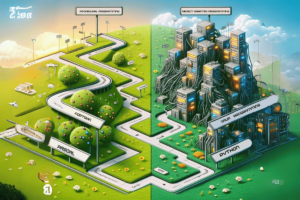Sure, You can use ChatGPT to Write Code: But Exactly, How Does ChatGPT Write Code?

Do you often find yourself wishing to write code, but struggling with where to start? Enter ChatGPT from OpenAI, this Large Language Model is a game changer in generating text such as writing essays. And now, we hear in the coding world that this version of ChatGPT can generate computer programming code. In this article, we will unravel the technical intricacies and answer exactly “How does ChatGPT write code?”.
Through your journey here, we will illuminate you on its functionality, reliability and future implications.
Intrigued yet? Stick around; magic awaits!
Key Takeaways
- ChatGPT can write computer programming code by narrowing down and refining requests, exploring libraries and resources, and generating example code.
- It simplifies the process of exploring libraries and resources by quickly searching for information on available options, recommending popular frameworks and tools, suggesting relevant documentation and tutorials, and leveraging existing code repositories like GitHub.
- Programmers play a crucial role in ensuring the reliability of generated code by providing clear instructions, refining requests, exploring resources, and performing thorough reviews before implementation.
- While AI-generated code from a bot can be helpful, it should always be reviewed by human programmers to ensure trustworthiness. Determining ownership rights for AI-generated code is also an important consideration.
How Can ChatGPT Write Computer Programming Code?
ChatGPT can write computer programming code by narrowing down and refining requests, exploring libraries and resources, and generating example code.
Narrowing down and refining requests
ChatGPT works on making sense of tricky requests that it gets. This process helps code writers get what they want. Here is how it happens:
- ChatGPT reads the user’s request.
- It breaks down the words and phrases into parts.
- It uses a tool called natural language processing to understand these parts.
- It checks if the parts link with coding words or ideas.
- If something is unclear, ChatGPT asks for more info.
- As it gets more info, it makes the request more precise.
- Then it starts forming code based on what it now knows.
- While doing this, it also looks at past codes for help.
Exploring libraries and resources
ChatGPT simplifies the process of exploring libraries and resources for computer programming needs.
- It can quickly search and provide information on available libraries and their functionalities.
- With its deep understanding of programming languages, ChatGPT can assist in finding the most suitable resources for specific tasks.
- It can recommend popular frameworks and tools that programmers commonly use, saving time in research.
- ChatGPT also excels at suggesting relevant documentation, tutorials, and examples to help users understand and implement specific functionalities.
- Its ability to generate example code further aids in exploring how different libraries and resources can be utilized.
- By analyzing language inputs related to the desired functionality, ChatGPT can suggest relevant libraries or code snippets from existing repositories like GitHub.
- This capability expands the options available for developers by presenting alternative approaches or lesser-known resources.
- The integration with GitHub Copilot allows ChatGPT to leverage a vast codebase, enabling it to learn from existing solutions and suggest informed coding recommendations.
Generating example code
ChatGPT is capable of generating example code to assist in computer programming tasks. This feature allows users to see how the code would look and function. With the help of ChatGPT to generate code, non-programmers can learn coding by observing and understanding these examples. It provides a valuable learning resource for beginners in programming. Additionally, programmers can use this feature to quickly generate code snippets for specific tasks, saving time and effort. The generated example code is derived from the analysis of language inputs and aims to meet the user’s requirements.
What is the Reliability and Limitations of ChatGPT Coding Skills?
There is no denying that there are some advantages to write code with ChatGPT. ChatGPT can provide efficiency for faster development times, automating repetitive programming tasks like boilerplate code, and as a learning aid for newer programmers to name a few. However, ChatGPT for coding has some limitations and may not be entirely reliable to render good code. This may require the role of human programmers to ensure generated code is trustworthy and meets specific requirements.
The role of programmers
Programmers play a crucial role in the coding process. They are responsible for translating human instructions into computer-readable code. While ChatGPT can generate code, it still relies on programmers to provide clear and specific instructions.
Programmers have the expertise to understand and refine requests, explore libraries and resources, and ensure that the generated code meets the desired outcome. Their knowledge helps bridge the gap between human language inputs and accurate code generation.
Additionally, programmers bring their experience and problem-solving skills to ensure reliable and trustworthy code execution. Their involvement is essential in achieving successful outcomes with AI-based coding assistance tools like ChatGPT.
Trustworthiness of generated code
ChatGPT’s ability to generate computer programming code raises questions about the trustworthiness of that code. It is important to remember that while ChatGPT can help you write code, and can produce useful snippets of code, it’s coding capabilities still has limitations.
The generated code should always be reviewed and tested by human programmers before being implemented in a project. Additionally, developers need to ensure the security and quality of the code they receive from AI chatbots like ChatGPT.
While this technology has great potential, it is crucial for CIOs, CTOs, and Computer Science majors to exercise caution and maintain a critical eye when using AI-generated code in their software development processes.
Ownership of code written with ChatGPT
Code written with ChatGPT raises questions about ownership. Since the chatbot generates code based on user prompts or information, the line between human-generated and AI-generated code becomes blurry.
While users may provide the initial guidance, ChatGPT ultimately uses its own language analysis to generate the code. This creates a unique situation where it’s not entirely clear who owns the resulting code.
Additionally, as AI-driven tools like OpenAI’s ChatGPT become more prevalent in software development, determining ownership rights and responsibilities will be crucial for legal and ethical reasons.
What are Some Technical Insights into ChatGPT’s Ability to Write Code?
Learn about the training process, neural nets, embeddings, and semantic grammar that power ChatGPT’s ability to generate computer programming code. Discover the fascinating world of AI-driven code generation!
Training process and neural nets
Using ChatGPT to create computer programming code is made possible through a rigorous training process and the power of neural networks. During training, ChatGPT is exposed to vast amounts of data from various sources, including programming languages, coding practices, and software development projects.
Neural networks are then used to analyze this data and learn patterns and relationships between different elements of code.
The training process involves multiple iterations where the neural network learns to predict the next word or token in a sequence based on previous information. This helps ChatGPT understand the structure and syntax of programming languages.
The more diverse and comprehensive the training data, the better ChatGPT becomes at generating accurate and meaningful code.
Neural networks play a crucial role in enabling ChatGPT’s understanding of complex language inputs for code generation. They are designed to identify patterns in text and make connections between words or phrases that have similar meanings.
By leveraging these connections, ChatGPT can generate contextually relevant code based on user prompts or queries.
Embeddings and semantic grammar
Both embeddings and semantic grammar are key components of ChatGPT’s functionality for writing computer programming code. The way language inputs are broken down into smaller components and analyzed based on their meanings is known as embeddings.
This process helps ChatGPT understand the context and intent behind the given text, allowing it to generate appropriate code responses. Semantic grammar, on the other hand, focuses on capturing the rules and structures of programming languages to ensure that generated code adheres to proper syntax and semantics.
By incorporating these techniques, ChatGPT is able to generate human-like code with accurate interpretations and meaningful results.
Meaning space and semantic laws of motion
ChatGPT’s ability to generate computer programming code relies on its understanding of the meaning space and semantic laws of motion. By analyzing language inputs, ChatGPT breaks down the text into smaller components and examines their meanings.
It then applies these meanings to generate a response that aligns with the given information.
The meaning space refers to the range of possible interpretations for a given piece of text. ChatGPT uses its training data and knowledge about programming languages to navigate this meaning space effectively.
It leverages semantic laws of motion, which are rules governing how different software components interact with each other in a meaningful way.
Understanding these laws allows ChatGPT to produce coherent and accurate code examples based on user requests. This feature is particularly beneficial for beginners learning how to code, as it provides detailed explanations that help them comprehend the generated code more easily.
How to Code with ChatGPT? : Use Case With the Programming Language Python
Decoding the Code Generation Process
When you ask ChatGPT to write code, ChatGPT employs a two-pronged approach:
• Database Lookup: ChatGPT first attempts to understand the coding task presented. It then searches its vast internal database for code snippets, or a piece of code, that align with the task. If a suitable snippet is found, ChatGPT modifies it to cater to the specific requirements.
• On-the-Fly Generation: If no matching snippet is found, ChatGPT harnesses its code generation capabilities. Drawing from its extensive training, it crafts a new code snippet from scratch, ensuring it aligns with the user’s request.
For instance, if a user prompts ChatGPT for a Python function to calculate the Fibonacci sequence, the model discerns the need for a function that computes Fibonacci numbers. It then either retrieves a relevant code snippet, or there is new code generated to ensure the output aligns with the Fibonacci sequence’s logic.
FAQs
1. What is ChatGPT?
ChatGPT, not Chat GPT, is an AI-based coding assistance tool that uses machine learning to generate computer code and helps improve your coding skills.
2. How does ChatGPT help non-programmers?
Non-programmers can use the code interpreter feature in a python environment to help them understand programming language analysis and enhance their computational thinking abilities.
3. Can I learn app development with ChatGPT?
Yes, you can explore AI-driven code generation techniques while learning useful insights about app development through its deep learning capabilities.
4. Does using ChatGPT require any prior knowledge of computer algorithms?
No, ChatGPT offers a comprehensive technical explanation on using LLMB-based AI tools so you don’t need to be skilled in computer algorithms already.
5. How does ChatGPT aid in self-solving tasks?
By generating artificial intelligence powered codes, it aids users by information retrieval from programming courses thus enabling them for self-solving tasks.
Conclusion
In conclusion, ChatGPT’s ability to write computer programming code is a significant advancement in the field of AI. By breaking down language inputs and analyzing meanings, it generates human-like code that can be useful for both beginners and experienced programmers.
However, its reliability and ethical considerations are important factors to consider as we explore the potential of AI-driven code generation. It will be awhile before we see ChatGPT replace programmers. As we continue to improve this technology, it has the potential to revolutionize coding practices and enhance the way developers work with programming languages.
If you liked this article, remember to subscribe to MiamiCloud.com. Connect. Learn. Innovate.






